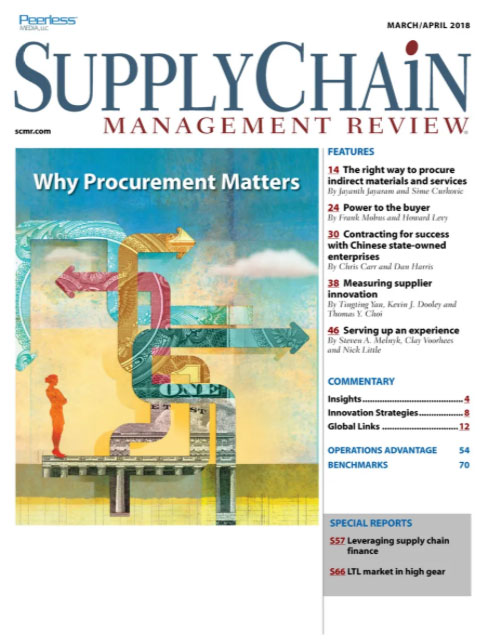Sorry, but your login has failed. Please recheck your login information and resubmit. If your subscription has expired, renew here.
March-April 2018
"Inflation creeps into U.S. Supply Chain.” So said the headline on a Wall Street Journal article I read this morning before writing this column. The Journal went on to write that U.S. companies are grappling with rising material and ingredient costs on top of pressure from higher wages—a potential double whammy— and noted that companies like Whirlpool and Ford have already issued warnings to the market. Browse this issue archive.Need Help? Contact customer service 847-559-7581 More options
Today’s supply chains increasingly rely on customized inputs rather than standardized commodities or services. Parts, software, machinery all the way up to totally outsourcing production to a contract manufacturer are often custom designed for the task at hand so that the supplier can effectively and efficiently drive the lowest total product cost. While that makes excellent business sense, it can create a major sourcing challenge because the supplier now becomes, in effect, a sole source. As the sole-source, the power in the relationship may shift to the supplier.
Much the same happens when the input has to be certified by a third party, like a customer up the supply chain or a government agency, such as the FDA or the FAA. The government agency may have certified only a few suppliers and possibly just one. Similarly, design engineering groups can provide the buyer with a specification conundrum where there is only one approved supplier at the raw material or finished product level.
The procurement problem is often compounded by the buyer’s actions. The buyer may over-commit business before gauging the supplier’s performance and end up being locked into working with an unsatisfactory firm. While it may be obvious to the buyer, a seller may not realize that they are in effect the sole-source. Instead they might find out how the buyer views things from “loose lips” in the buying firm, quite possibly side comments made by someone not involved in procurement, for instance, from engineering or quality.

This complete article is available to subscribers only.
Log in now for full access or start your PLUS+ subscription for instant access.
SC
MR
Sorry, but your login has failed. Please recheck your login information and resubmit. If your subscription has expired, renew here.
March-April 2018
"Inflation creeps into U.S. Supply Chain.” So said the headline on a Wall Street Journal article I read this morning before writing this column. The Journal went on to write that U.S. companies are grappling… Browse this issue archive. Access your online digital edition. Download a PDF file of the March-April 2018 issue.Today's supply chains increasingly rely on customized inputs rather than standardized commodities or services. Parts, software, machinery all the way up to totally outsourcing production to a contract manufacturer are often custom designed for the task at hand so that the supplier can effectively and efficiently drive the lowest total product cost. While that makes excellent business sense, it can create a major sourcing challenge because the supplier now becomes, in effect, a sole source. As the sole-source, the power in the relationship may shift to the supplier.
Much the same happens when the input has to be certified by a third party, like a customer up the supply chain or a government agency, such as the FDA or the FAA. The government agency may have certified only a few suppliers and possibly just one. Similarly, design engineering groups can provide the buyer with a specification conundrum where there is only one approved supplier at the raw material or finished product level.
The procurement problem is often compounded by the buyer's actions. The buyer may over-commit business before gauging the supplier's performance and end up being locked into working with an unsatisfactory firm. While it may be obvious to the buyer, a seller may not realize that they are in effect the sole-source. Instead they might find out how the buyer views things from “loose lips” in the buying firm, quite possibly side comments made by someone not involved in procurement, for instance, from engineering or quality.
SC
MR


Latest Supply Chain News
- Israel, Ukraine aid package to increase pressure on aerospace and defense supply chains
- How CPG brands can deliver on supplier diversity promises
- How S&OP provides the answer to in-demand products
- AI, virtual reality is bringing experiential learning into the modern age
- Humanoid robots’ place in an intralogistics smart robot strategy
- More News
Latest Podcast

 Explore
Explore
Procurement & Sourcing News
- Israel, Ukraine aid package to increase pressure on aerospace and defense supply chains
- How CPG brands can deliver on supplier diversity promises
- How S&OP provides the answer to in-demand products
- There is still work to do to achieve supply chain stability
- Blooming success: The vital role of S&OE in nurturing global supply chains
- How one small part held up shipments of thousands of autos
- More Procurement & Sourcing
Latest Procurement & Sourcing Resources

Subscribe

Supply Chain Management Review delivers the best industry content.

Editors’ Picks






